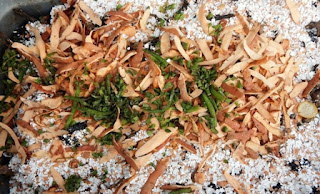Composting is Easy
Part Two
Unless you buy organic or grow your own fruits and veggies most of the food you eat probably contains chemicals. As a rule processed food generally has more chemicals so for my compost materials I gravitate towards scraps from fresh fruits.
During the summer months, I frequently add watermelon and cantaloupe rinds. I also add banana peels, apple cores, corn husk, tomatoes that are starting to go bad and pineapple skins. It is important that you cut your compost materials into small pieces so that it can break down faster.
Your composter or compost pile needs a proper ratio of carbon-rich materials, or “browns,” and nitrogen-rich materials, or “greens.” Among the brown materials are dried leaves, straw, and wood chips. Nitrogen materials are fresh or green, such as grass clippings and kitchen scraps.
Source
The time it takes to break down the items in your bin depends on what and how much you add. I deliberately worked my compost bin for the entire summer because I felt that leaves would be an important component. The photos above shows leaves, grass clippings and coffee grounds I got for free at the local Starbucks. The are happy to get rid of them but don't just show up call first and bring your own bin or some sort of container.
Any type of potato skins is fine. Here you see sweet potato peels also tips from green beans and lots of crushed brown and white egg shells.
It is very important to keep your compost moist.
Instagram
Facebook
Part Two
Unless you buy organic or grow your own fruits and veggies most of the food you eat probably contains chemicals. As a rule processed food generally has more chemicals so for my compost materials I gravitate towards scraps from fresh fruits.
During the summer months, I frequently add watermelon and cantaloupe rinds. I also add banana peels, apple cores, corn husk, tomatoes that are starting to go bad and pineapple skins. It is important that you cut your compost materials into small pieces so that it can break down faster.
Your composter or compost pile needs a proper ratio of carbon-rich materials, or “browns,” and nitrogen-rich materials, or “greens.” Among the brown materials are dried leaves, straw, and wood chips. Nitrogen materials are fresh or green, such as grass clippings and kitchen scraps.
Source
Compost Materials - Compost Guide
Any type of potato skins is fine. Here you see sweet potato peels also tips from green beans and lots of crushed brown and white egg shells.
It is very important to keep your compost moist.






Comments
Post a Comment